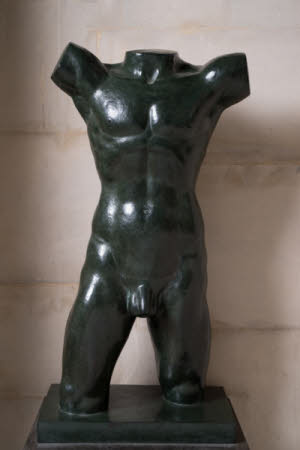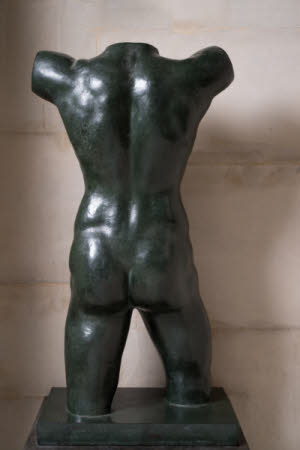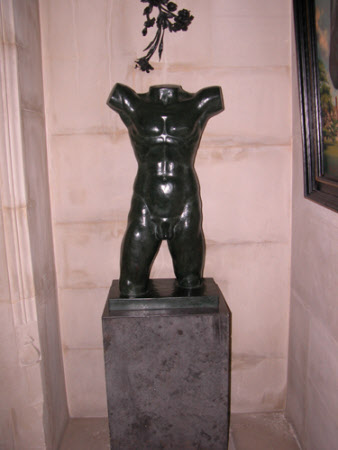Torso Study
Arnold Auerbach (Liverpool 1898 - 1978)
Category
Art / Sculpture
Date
1945
Materials
Bronze
Measurements
735 x 525 mm
Place of origin
London
Order this imageCollection
Anglesey Abbey, Cambridgeshire
NT 514938
Summary
Bronze, Torso Study, Arnold Auerbach (Liverpool 1898 – 1978), 1945. A cast bronze male torso by Arnold Auerbach, extending to the knees, cut off at top of arms and head, on a rectangular base, inscribed 'ARNOLD AUERBACH ’45 LONDON/1'.
Full description
Arnold Auerbach was a gifted but today all but forgotten artist, who practised principally as a sculptor, but also as a painter and printmaker. Born in Liverpool in 1898, Auerbach was the grandchild of Polish immigrants. After training at the Liverpool College of Art and service in the Army during the First World War, Auerbach began to work for the Liverpool architect James Bramwell, specialising in the sculptural aspects of interior decorations. In 1921 he moved to London and made a study trip to the Continent, where he was especially impressed in Paris by the work of contemporary sculptors, such as Aristide Maillol, Alexander Archipenko, Henri Laurens, Jacques Lipchitz and Ossip Zadkine. Having obtained a studio in Hampstead, Auerbach spent much of the 1920s contributing to Art Deco interiors in London whilst, from 1923 until 1945, he exhibit periodically at the Royal Academy. His early influences included the monumental and simplified aspects of ancient Egyptian sculpture, whilst in the 1930s he experimented with more fragmented cubist forms. Late in his career Auerbach returned to a more naturalistic style. He was forced through ill health to give up sculpting in the mid-1950s, spending much of the latter decades of his career, from the Second World War through to his retirement in 1968, teaching, successively at the Beckenham School of Art, the Regent Street Polytechnic, Chelsea School of Art and the Stanhope Institute. Arnold Auerbach’s interest in education was reflected in two books that he wrote, 'Sculpture. A History in Brief' (London 1952) and 'Modelled Sculpture and Plaster Casting' (London 1961). In the final chapter of 'Sculpture', Auerbach considered at some length the nature of sculpture and, in particular, the 20th-century dilemma of abstraction versus natural form: ‘in this sense, with the abstract sculptor, there is no longer any real subject matter except the feelings of the artist, and those feelings are themselves capable of expression – of materialisation – only in terms of shape, as far as the sculptor as such is concerned. If he chooses abstract forms to take the impress of his feelings it is because, in so far as the forms become more generalised, so much the less will they tend to resemble particular things in the natural world. The less, therefore, they will be likely to convey precise intellectual information, and will the better respond to shades of feeling purely; just as musical notation responds to the feelings which the composer wishes to convey, without carrying any other meaning. […] But we are entitled, also, to ask whether these abstract shapes are really capable of carrying such a weight and variety of meaning, of responding with sufficient flexibility to the sculptor’s feelings […] so enormous is the variety of forms in nature, and so consistently under our eyes, that it is almost difficult to avoid making a shape which is not in some degree reminiscent or suggestive of living forms.' (Sculpture, pp. 99-100) Auerbach went on to describe what he called ‘the fundamental nature of sculpture’: ‘Whether sculpture be made in the likeness of anything else outside itself or not, that descriptive likeness is never its essential sculptural quality. Its essential quality, the quality which is its irreducible quality, resides in its own physical shape and the feelings which may be aroused by the sort of order which that shape establishes. For that order, that physical relationship of the masses, the planes, the lines – its form – is the representative of the spirit of its maker.’ (Sculpture, p. 100) His book concluded with an attempt to define what can be meant by ‘beauty’ in sculpture: ‘The beauty of sculpture resides not in what it records, though it may well record beauty too, but in some fine shaping of the material, so that the spirit enters into its form. Where there is sculptural form there is beauty, for the mark of life is upon it.’ (Sculpture, p. 103) Auerbach’s Torso Study was almost certainly the work exhibited by the sculptor with that title at the 1945 Royal Academy Summer Exhibition (no. 1306), in fact the last time that the artist was to exhibit at the RA. In the 1945 exhibition, he also showed an ‘Auto-portrait: head’ (no. 1366). The medium of the Torso Study was not specified in the catalogue, but it may have been the sculpture now at Anglesey Abbey or else a plaster, from which Lord Fairhaven commissioned a bronze cast. The number ‘1’ on the inscription of the base of the Torso Study suggests in any event that, at least in 1945, just a single bronze cast had been made from the plaster model. A 1948 painting depicts a corner of Auerbach’s studio, with in the centre what is either the bronze acquired by Lord Fairhaven or its original model (Arnold Auerbach Studio Sale, Phillips, London, 29 October 1979, lot 71, ill. Pl. 9); the painting is copied for in an etching dated 1949 (Phillips sale, lot 72; Elizabeth Harvey-Lee, Arnold Auerbach 1898-1978. A Centenary Tribute to a Sculptor’s Graphic Art, North Aston 1998, no. 22, ill. on back cover). The sculpture in these pictures is on an identical rectangular base to the version now at Anglesey Abbey. The contents of Auerbach’s studio were sold at Phillips after the sculptor’s death, in 1979 (Arnold Auerbach Studio Sale, Phillips, London, 29 October 1979). A few years later, in 1984, the Galerie Huber and Reichard in Offenbach am Main showed a selection of his sculptures, in posthumous casts in bronze made from the original plaster models, cast in editions of eight (René Reichard, Arnold Auerbach. Leben und künstlerisches Werk/The Life and art of Arnold Auerbach, Galerie Huber and Reichard, Offenbach am Main 1984). Two of the bronze casts were acquired by the Tate Gallery, Mechanised Head of 1928 and Torso, also from 1928 (T04111 and T04112). In the catalogue, René Reichard illustrated a number of Auerbach’s female torso sculptures (figs. 10, 12, 20, 23), suggesting the problem of the torso ‘formed the basis of Auerbach’s work,’ ‘a self-contained volume, the sharp outline separates it from its space’. It preoccupied the sculptor throughout his career and seems to have been of more importance to him than images of the entire body. No version of Torso Study appeared either in the Studio sale or in the Huber and Reichard exhibition, suggesting that the sculpture shown by Auerbach in his painting and etching, with its identical base, might indeed be the bronze cast presumably acquired directly from the artist at some point by Lord Fairhaven. The work is one of the last major sculptures that Arnold Auerbach ever produced. The only later recorded work is the bronze sculpture Dark Maternity of 1946, a moving Virgin and Child image in the modernist idiom (Sculpture, fig. 67; Arnold Auerbach, p. 24, fig. 24). Jeremy Warren 2019
Provenance
Possibly acquired at the Royal Academy Summer Exhibition, 1945; or after 1949; bequeathed to the National Trust by Urban Huttleston Rogers Broughton, 1st Lord Fairhaven (1896-1966) with the house and the rest of the contents.
Credit line
Anglesey Abbey, The Fairhaven Collection (The National Trust)
Marks and inscriptions
On rear edge of base: ARNOLD AUERBACH ’45 LONDON/1
Makers and roles
Arnold Auerbach (Liverpool 1898 - 1978), sculptor
References
Christie, Manson & Woods 1971: The National Trust, Anglesey Abbey, Cambridge. Inventory: Furniture, Textiles, Porcelain, Bronzes, Sculpture and Garden Ornaments’, 1971, p. 147. The Exhibition of the Royal Academy, 1945. The 177th., London 1945, p. 64, no. 1306.



